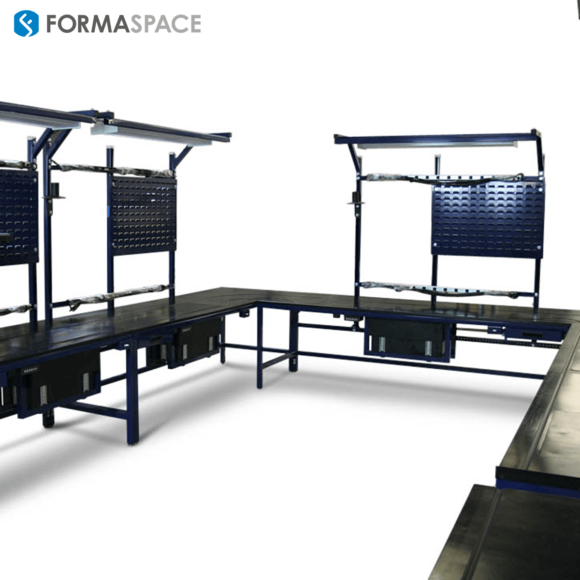Green Timing Poses an Opportunity – and a Major Challenge – for Manufacturing Companies
Cheap renewable energy from solar and wind sources offers a great opportunity for manufacturing companies that are urgently seeking ways to significantly reduce their expenditures on expensive energy supplies.
But getting there will require some significant changes in the way we consume energy.
In this Formaspace report, we look at the opportunities and challenges of Green Timing, the practice of optimizing energy use to synchronize it with green energy production.

What’s all the Fuss About? Why the Need to Change?
The traditional role of electricity grid operators is to carefully match the production of electricity with the rate of demand. But if demand ever exceeds supply, the grid operators will need to initiate sudden blackouts to protect the grid from damage.
The traditional approach grid operators have used for decades is to produce daily “energy use” forecasts and place power generation sources (whether coal, gas, nuclear, or hydroelectric) on standby reserve, ready to fire up as demand rises.
Electricity demand typically surges in the morning as people rise to prepare for work and school. It peaks again in the late afternoon as workers come home and switch on air conditioners to cool buildings or use appliances for cooking or cleaning. Demand then drops significantly overnight.
To smooth out the demand curve, utilities have long offered variable rates to industrial customers (and residential customers with smart meters), encouraging them to use more electricity at night and less during the day – which reduces the need for capital investments in new power generation facilities to meet peak demand during the day.

Renewable Energy Sources are Significantly Cheaper but Far Less Predictable
Renewable energy sources, such as solar and wind, have thrown a monkey wrench into the careful planning matching production with demand.
Wind and solar energy production can provide significant amounts of very cheap electricity during the day – with far less capital investment compared to building a new fossil fuel or nuclear power plant (assuming there are sufficient transmission lines to connect them to the major power grids).
However, as soon as the sun goes down (which also tends to cause the winds to decrease), utility operators need to turn to other energy sources to keep the lights on. (Cloudy or windless days also curtail solar and wind energy significantly, adding to the unpredictability issue.)
AI-Powered Tools Can Forecast Availability of Green Energy Sources
Thus, renewable solar and wind are both a salvation (due to their low cost) and a curse (due to unpredictability) for utility operators.
Assuming for a moment that storing electricity at scale is not yet economical – a point we will address below – operators and federal regulators are looking at how to implement Green Timing mechanisms that match electric demand with production.
Traditionally energy utilities have relied on variable pricing to encourage industrial and consumer users to change their behavior.
Back in the day, industrial manufacturing companies could (if they chose to) adjust their energy-intensive process schedules to take advantage of lower electricity rates at night.

But with solar and wind, the cheapest time of day to produce electricity on a sunny day might be in the heat of the afternoon, when the sun and the winds are strongest – but the situation might be different on a windless, cloudy day.
Utility operators are expanding their forecasting tools by adding AI-powered data analysis capabilities to predict when the “greenest” electricity will be available.
However, on the demand side, keeping track of these changes “manually” throughout the day is too difficult for industrial and consumer users – making this an ideal problem to automate.
This is where Green Timing and micro-scheduling come into play – an approach where utility operators share their green energy usage and production forecasts directly with smart, internet-connected appliances and equipment.
You may be using Green Timing technology without even knowing it.
Apple recently introduced a Green Timing feature for iPhones. The company gathers energy supply data from utility operators across the country and uses an AI-powered algorithm to adjust when each iPhone draws power from the local grid to top up its battery. For example, if Apple knows you tend to keep the phone plugged in during the day, it might recharge your phone when more solar and wind power is available in your area.

EV manufacturers are also looking at Green Timing technology. EV owners generally expect to charge their vehicles overnight (when rates are typically lower), but the greenest energy might be available during the day when solar and wind power are at a maximum. (Whether the local utility passes along the savings is a separate but important question.) In the future, it’s likely that EVs will automatically shift charging times to match the availability of the greenest energy.
We can expect this Green Timing approach to expand to incorporate other appliances and industrial equipment soon as well.
Energy Storage Systems to Smooth Out Startup Surge and Peak Use Power Demands
What are some of the other changes we can expect as part of this new Green Timing approach to grid management?
Before we get into the topic of batteries and energy storage, let’s take a moment to discuss how equipment and appliance startup surge is a problem that needs to be addressed.
You may be familiar with the lights dimming when you first turn on an air conditioner – this occurs because the AC unit draws a far greater amperage during its startup sequence. This power surge at startup happens with other big equipment and appliances as well. For example, utility operators in the UK well know they have to be prepared to handle the surge in power usage that takes place during the commercial breaks of popular television shows as millions of Brits turn on their electric kettles for a cup of tea.
Equipment and appliances can be redesigned to reduce this surge, and we expect there will be new recommendations or regulations to encourage this. For example, air conditioners can be equipped with “slow start” capacitors that reduce the power surge at startup. Appliances ranging from microwaves to induction cooktops to tea kettles can be equipped with supplementary battery power to reduce the sudden draw on the power grid.
But while these are useful point solutions that can add up to significant reductions in power surges taxing the electrical grid, many analysts feel that the missing link is still industrial-scale batteries that can store excess solar and wind power generated during the day for use a night.
The Biden Administration’s Carrot and Stick Approach to Creating a Domestic Battery Industry
As noted earlier, one of the main challenges for electrical grid operators is the need to match electric production supply with instantaneous user demand – if this goes out of balance, the grid will crash, resulting in an unplanned blackout.
Industrial-scale batteries could change this equation if we could only produce enough of them at economical prices. Grid operators could store excess solar and wind energy produced during the day to supply power at night, for example.
To get there, we need to increase domestic battery production; otherwise, we will be further dependent on suppliers in China that have a significant first-mover advantage in battery manufacturing.
The Biden Administration’s Inflation Reduction Act (IRA) offers several carrots to encourage both industrial battery manufacturing and adoption by consumers.
The main incentive to create a robust domestic battery manufacturing industry is IRA Section 13502, which offers an “Advanced Manufacturing Production Credit” direct to manufacturers. For each kilowatt hour of domestic battery power production, the available credit is $45 – $35 of which is for manufacturing domestically sourced battery cells, with the remaining $10 credited for assembling the modules into a case. (In case you are wondering, the IRA also offers a $45 credit per kilowatt hour for complete batteries that do not use traditional “cells.”)
Most casual observers assume that these IRA manufacturing credits are targeted at batteries destined for use in EVs – however, the law is agnostic on how the batteries are put into service, and we predict utilities will start to invest in large-scale electrical grid battery storage systems to reduce their overall capital expenditures on fossil fuel power plants.
The IRA offers carrots to residential users as well.
Perhaps the best known is the $7,500 tax credit for purchasing a new EV. The fine print in the law limits the availability of this credit in many cases, however; it’s subject to income restrictions as well as whether the vehicles and the batteries (and battery raw materials) are made in/sourced from America or countries with a free trade agreement with the US. (Commercial vehicle transactions are excluded from these restrictions, so leasing companies are using this loophole to offer full credit to customers who lease EVs.)
IRA Section 48(a)(3)(A)(ix) also offers a 30% investment tax credit (ITC) for residential customers who invest in 3 kWh or larger standalone battery systems, whether they are connected to a solar system or not.
So far, we’ve talked about some of the carrots the Biden administration is offering to move toward a greener electrical grid, but what about any “sticks” coming down the pike?
Rest assured, they are coming.
The first salvo is expected to come this week in the form of a new proposed rule from the EPA that would significantly tighten tailpipe emissions from ICE engines in the coming years.
According to reporting from the NY Times, the EPA’s National Fuel and Vehicle Emissions Laboratory has been undertaking rigorous tests and computer simulations of current generation EVs – with an eye toward predicting how fast the country could transition to electric vehicles.
Informed by these laboratory results, the EPA will announce a new lower threshold for gasoline-powered ICE vehicles this week – one that is said to be so strict that it will force the hand of vehicle manufacturers to dramatically bump up the percentage of EV sales to between 54 and 60 percent by 2030 and to between 64 – 67 by 2032.
Will Green Timing Suffer the Wrath of Political Critics and Conspiracy Theorists?
Will Green Timing and these other energy innovations come under attack before they can prove their worth in the marketplace?
If the past is a prologue, the signs are not encouraging.
You may recall some of the outrage directed at utility companies when they first introduced smart meters – with some conspiracy theorists claiming the meters were being used to “spy” on individuals in their homes.
Apple’s Green Timing initiative for charging iPhones has been met with similar controversy in some circles, with some claiming that the phone choosing when to recharge represents an incursion into personal freedoms.
Somewhat surprisingly, the IRA credits offered to manufacturers and consumers have not yet seemed to have drawn the extreme wraith of opposition voices, but that may change in the lead-up to the 2024 US presidential election.
IRA advocates point to the rapid major investments that manufacturing companies are making in expanding battery manufacturing across the country. Many of these new factories are breaking ground in conservative states, and the resulting influx of new jobs may mitigate criticisms over the cost of Federal funding of the IRA tax credit provisions.
Time will tell how this will turn out between now and the end of this decade.

Formaspace is Your Research Lab, Manufacturing Facility, and Material Handling Partner
If you can imagine it, we can build it here at our factory headquarters in Austin, Texas.
Talk to your Formaspace Design Consultant today to see how we can make your next laboratory, manufacturing facility, or material handling project a success.












